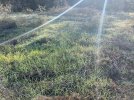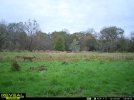txbowman12
A good 3 year old buck
Preparing for a Spring planting in a few weeks that will be primarily to build OM and get prepped for a healthy fall plot. Soil test results are due back any day now. Soil type is decent, sandy loam. Currently a cattle pasture. I've fenced out (3 strand e-fence) just under 2 acres. Call it 1.75. Area has a fair amount of good native habitat, but, like most texas properties in that area, has a lot of cattle on it. Good soil and 30+ inches of rain a year
Seed species are buckwheat (50 lbs), deer vetch (10lbs), alyce clover (10 lbs), and sunn hemp (10 lbs).
I sprayed and fenced last weekend, and planned to simply scatter seed and pack it in with a lawn roller. Along with appropriate fertilization (I think PH will be workable but will lime if called for).
Here is my issue. I don't have that tall standing thatch that most of the successful TnM plots I've seen on here have due to the cattle grazing. I could probably get a tractor out there to disc if it really came down to it, but the area has been pretty heavily pitted / clumped in certain areas over the years and would result in a lot of topsoil loss getting things smooth. I've considered a couple of options
1. Stick to the plan and throw and roll with a heavy lawn roller behind my utv
2. Use a drag harrow to rough up the dirt some and then roll (drag harrow would also handle the bumps better than a roller)
3. Buy something like the groundhog max or a different atv disc and use that to lightly disc and then roll.
4. Break up the dirt with a plug aerator before seeding
Learned a lot from reading through the threads on here. Thanks in advance for any advice / warnings!
Seed species are buckwheat (50 lbs), deer vetch (10lbs), alyce clover (10 lbs), and sunn hemp (10 lbs).
I sprayed and fenced last weekend, and planned to simply scatter seed and pack it in with a lawn roller. Along with appropriate fertilization (I think PH will be workable but will lime if called for).
Here is my issue. I don't have that tall standing thatch that most of the successful TnM plots I've seen on here have due to the cattle grazing. I could probably get a tractor out there to disc if it really came down to it, but the area has been pretty heavily pitted / clumped in certain areas over the years and would result in a lot of topsoil loss getting things smooth. I've considered a couple of options
1. Stick to the plan and throw and roll with a heavy lawn roller behind my utv
2. Use a drag harrow to rough up the dirt some and then roll (drag harrow would also handle the bumps better than a roller)
3. Buy something like the groundhog max or a different atv disc and use that to lightly disc and then roll.
4. Break up the dirt with a plug aerator before seeding
Learned a lot from reading through the threads on here. Thanks in advance for any advice / warnings!





